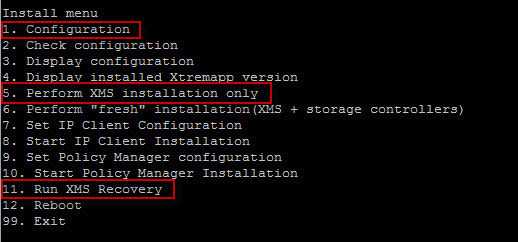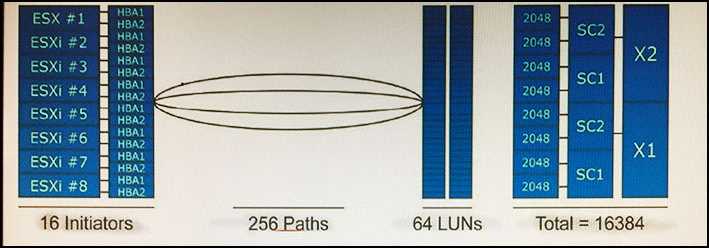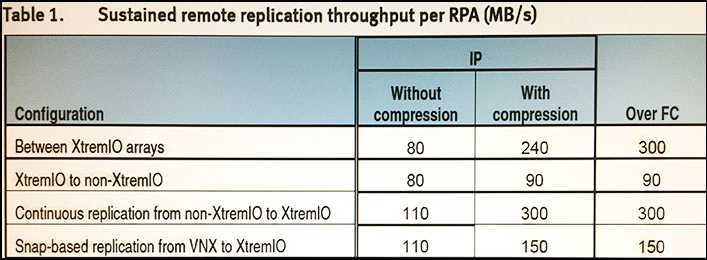Dell EMC e20-526 practice test
Technology Architect, XtremIO Solutions Specialist Exam
Last exam update: Jun 26 ,2025
Question 1
You need to design an Oracle solution for a customer. Which XtremIO best practices should be used
in Oracle environments?
- A. Use a 512 byte LUN sector size for databases. Use Eager Zeroed Thick formatting for ESXi
- B. Use a 4 kB LUN sector size for databases. Use Lazy Zeroed Thick formatting for ESXi
- C. Align data on 4 kB boundaries. Use Thin formatting on ESXi
- D. Align data on 4 kB boundaries. Use Lazy Zeroed Thick formatting on ESXi
Answer:
A
Explanation:
The default setting for XtremIO volumes is 512e. It is recommended not to alter this in order to use
4K Advanced Format for Oracle Database deployments. There are no performance ramifications
when using 512e volumes in conjunction with an Oracle database. On the contrary, 4K Advanced
Format is rejected by many elements of the Oracle and Linux operating system stack.
References:https://www.emc.com/collateral/white-papers/h13497-oracle-best-practices-xtremio-
wp.pdf, page 20
Question 2
A physical XtremIO Management Server (XMS) has failed and requires replacement. Which two
software packages are required for recovery?
- A. XMS image and OVA image
- B. Xtremapp and OVA image
- C. XMS image and Xtremapp
- D. Xtremapp and MPIO
Answer:
C
Explanation:
The first step is to re-install the XMS image, in the event it is a physical XMS then you may install an
image via a USB flash drive or for a virtual XMS simply deploy the provided VMware OVA image.
The following step is to upload the XMS software to the images directory of the XMS and login with
install mode ..
Once logged into the XMS console with xinstall then perform the following sequence of steps:
1. Configuration
5. Perform XMS installation only
11. Run XMS Recovery
Options to choose when running the XMS Recovery:
References:https://davidring.ie/2015/02/20/emc-xtremio-redeploying-xms-xtremio-management-
server/
Question 3
A customer is considering XtremIO storage for their current Virtual Desktop Infrastructure (VDI)
deployment. The customer wants information on the benefits of an XtremIO solution.
What are the benefits of an XtremIO solution for this environment?
- A. Latency is less than 1 ms for all large I/O sizes, deduplication with compression, and scales linearly
- B. Latency is less than 1 ms for large I/O sizes, deduplication and compression, and no reduction in power and cooling costs
- C. Latency is less than 1 ms for small I/O sizes, scales linearly, and slightly higher cost/IOP/GB than hybrid arrays
- D. Latency is less than 1 ms for small I/O sizes, deduplication and compression, and scales linearly
Answer:
A
Explanation:
Storage capacity and performance scale linearly, such that two X-Bricks supply twice the IOPS, four X-
Bricks supply four times the IOPS, six X-Bricks supply six times the IOPS and eight X-Bricks supply
eight times the IOPS of the single X-Brick configuration. However, the latency remains consistently
low (less than 1ms) as the system scales out. The sub-millisecond latency is validated by actual test
results, and is determined according to the worst-case scenario.
References: Introduction to the EMC XtremIO STORAGE ARRAY (April 2015), page 37
Question 4
A customer is considering migrating their existing non-EMC storage arrays to an XtremIO array. The
current environment consists of 350 servers running VMware ESXi 5.5 with 5000 virtual machines.
The customer has various tools in place to monitor performance and collect statistics. On average,
their service time is 32 ms and utilization is at 75%. In the past, the customer has had performance
issues.
Based on Littles Law, what is the calculated response time on the existing environment?
- A. 128 ms
- B. 192 ms
- C. 256 ms
- D. 332 ms
Answer:
A
Explanation:
Disk service time T(s) = 32 ms (service time for one I/O).
Response time T(r) is calculated as: T(s) / (1 Utilization), which here calculates to 32 ms/ (1-0.75) =
128 ms.
References:https://community.emc.com/thread/145100?tstart=0
Question 5
A customer has recently deployed an XtremIO 20 TB two X-Brick cluster to run an existing instance of
Oracle RAC previously leveraging VNX for back-end storage. The application environment uses a
block size of 1 MB. Multiple tables are in use with the PARALLEL_DEGREE_POLICY variable set to
AUTO.
The customer wants your help with tuning the DB_FILE_MULTIBLOCK_READ_COUNT parameter for
best performance with XtremIO. Which values should be recommended for tuning the
DB_FILE_MULTIBLOCK_READ_COUNT parameter in the Oracle RAC environment?
- A. 8 or 16
- B. 24 or 32
- C. 64 or 128
- D. 256 or 512
Answer:
C
Explanation:
Oracle Database performs I/O on data files in multiples of the database block size (db_block_size),
which is 8KB by default. The default Oracle Database block size is optimal on XtremIO. XtremIO
supports larger block sizes as well. In the case of multiblock I/O (e.g., table/index scans with access
method
full),
one
should
tune
the
Oracle
Database
initialization
parameter
db_file_multiblock_read_count to limit the requests to 128KB.
Therefore, the formula for db_file_multiblock_read_count is:
db_file_multiblock_read_count = 128KB / db_block_size
In our case the block size is 1 MB, so the formula db_file_multiblock_read_count is 1 MB/ 8KB =
1024/8 = 128
References:https://www.emc.com/collateral/white-papers/h13497-oracle-best-practices-xtremio-
wp.pdf, page 21
Question 6
What is the maximum speed of the Fibre Channel ports on an XtremIO storage controller?
- A. 2 Gb/s
- B. 4 Gb/s
- C. 8 Gb/s
- D. 16 Gb/s
Answer:
C
Explanation:
Each Storage Controller includes two 8Gb/s Fibre Channel (FC) ports.
References: Introduction to the EMC XtremIO STORAGE ARRAY (April 2015), page 8
Question 7

As shown in the exhibit, a customers environment is configured as follows:
What should be the host queue depth setting per path?
- A. 64
- B. 128
- C. 256
- D. 1024
Answer:
C
Explanation:
The queue depth is per-LUN, and not per-initiator. Here there are 64 LUNs, each visible through 4
paths, which would indicate that 256 is a good choice for the queue depth setting.
Note: As a general advice, for optimal operation with XtremIO storage, consider the following: Set
the queue depth to 256.
References:https://www.emc.com/collateral/white-paper/h14583-wp-best-practice-sql-server-
xtremio.pdf
Question 8
A customer is interested in purchasing XtremIO for their mission critical database applications that
require the lowest possible response times. They have two data centers in which they want to
introduce All-Flash arrays. However, they need a way to maintain true active/active access to all
databases and application LUNs across both sites.
What is the recommended solution to address the requirements?
- A. ViPR Controller with XtremIO
- B. RecoverPoint with XtremIO
- C. VPLEX Metro with XtremIO
- D. ViPR SRM with XtremIO
Answer:
C
Explanation:
The EMC VPLEX family is the next-generation solution for data mobility and access within, across and
between data centers.
VPLEX supports two configurations, local and metro. In the case of VPLEX Metro with the optional
VPLEX Witness and Cross-Connected configuration, applications continue to operate in the surviving
site with no interruption or downtime. Storage resources virtualized by VPLEX cooperate through the
stack, with the ability to dynamically move applications and data across geographies and service
providers.
Question 9
A customer has two XtremIO clusters running 3.x software release. The customer just purchased a
new XtremIO array that will be installed with the latest 4.x software release.
What is the minimum number of XtremIO Management Server(s) that will be required to manage all
clusters?
- A. 1
- B. 2
- C. 3
- D. 4
Answer:
C
Explanation:
The system operation is controlled via a stand-alone dedicated Linux-based server, called the
XtremIO Management Server (XMS). A single XMS can manage multiple clusters. Multiple cluster
management is supported from version 4.0 and up. System version 4.0 supports up to eight clusters
managed by an XMS in a given site.
References: Introduction to the EMC XtremIO STORAGE ARRAY (April 2015), page 48
Question 10
What is a method to establish an XMCLI session?
- A. Use the PuTTY SSH tool configured for the serial port and xmsupload credentials
- B. Use the Telnet SSH tool configured on Port 443 and root credentials
- C. Use the CLI terminal in the Administration tab and root credentials
- D. Use the PuTTY SSH tool configured for Port 22 and xmsadmin credentials
Answer:
D
Explanation:
The system's Command Line Interface (CLI) allows administrators and other system users to perform
supported management operations. It is preinstalled on the XMS and can be accessed using the
standard SSH protocol.
PuTTY is an SSH and telnet client.
The standard TCP port 22 has been assigned for contacting SSH servers.
You can login using the builtin xmsadmin account.
References: Introduction to the EMC XtremIO STORAGE ARRAY (April 2015), page 50
Question 11
Which part of the XtremIO architecture do host ports use to access an XtremIO volume?
- A. FA
- B. Initiator
- C. Target
- D. Zone
Answer:
D
Explanation:
All XtremIO's enterprise features (including Inline Data Reduction, snapshots, XDP, HA, etc.) have
been developed as part of the scale-out architecture. All data and metadata are evenly distributed
across the entire cluster. I/Os are admitted to the array via all the host ports, utilizing SAN zones and
multi-pathing.
References: Introduction to the EMC XtremIO STORAGE ARRAY (April 2015), page 39
Question 12
A customer currently uses XtremIO native remote replication with four RPAs and a 1 GB WAN link to
asynchronously protect all production dat
a. Management has decided that all data stored on the XtremIO must now be protected at the
disaster recovery site by synchronous replication.
How can this be achieved?
- A. Set the Link Policy to Synchronous, Dynamic by throughput
- B. Purchase four additional RPAs.
- C. Set the Link Policy to Synchronous, Dynamic by latency
- D. Use a VPLEX splitter
Answer:
D
Explanation:
XtremIO with VPLEX provides for both synchronous and asynchronous replication.
Note: The engine of RecoverPoint is the RecoverPoint Appliance (RPA).
Question 13
Which values are required to enter a generic workload into the XtremIO Sizing Tool?
- A. Capacity, IOPs, R/W ratio
- B. IOPs, I/O size, bandwidth
- C. IOPs, bandwidth, latency
- D. Bandwidth, I/O size, latency
Answer:
C
Explanation:
IDC outlines a criteria some criteria for selecting a testing tool:
* Generate workloads
* Capture results for analysis:
Throughput
IOPS
Latency
References:http://emc.co/collateral/technical-documentation/h15280-euc-xendesktop-vsphere-
xtremio-sg.pdf, page 87
http://info.xtremio.com/rs/xtremio/images/IDC_Flash_Array_Test_Guide.pdf, page 7
Question 14
A customer has an existing Oracle environment they are considering moving over to XtremIO from
VMAX for improved performance. The customer wants to know the expected deduplication and
compression savings they can achieve with XtremIO.
Which tool is appropriate for conducting this assessment?
- A. EMC Backup Tool
- B. EMC Storage Tool
- C. XtremIO Sizing Tool
- D. EMC MiTrend Tool
Answer:
D
Explanation:
MiTrend has been available for EMC Employees and Partners for years, but its a valuable tool that
Customers can take advantage of also. And the price is awesome. Its FREE !
Use it for VNX, Clariion, VMAX, and many more.
References:http://www.pragmaticio.com/2014/11/mitrend-self-service-performance-analysis-for-
emc-vnx/
Question 15

Refer to the Exhibit.
A customer has the following XtremIO environment:
If an application generates 100,000 IOPS of traffic, how many RPAs are needed to replicate the traffic
from one XtremIO array to another XtremIO array over IP?
- A. 1
- B. 2
- C. 3
- D. 4
Answer:
C
Explanation:
Required bandwidth= 100,000 * 8 * 1024 bytes
Provided bandwidth between XtremIO arrays with compression over Fiber Channel: 300 * 1024 *
1024 bytes
Required number of RPAs: 100,000 * 8 * 1024 / (300 * 1024 * 1024) = 800,000 / (300 * 1024) = 2.6.
Three RPAs would be enough.